Imagine, if you will, a cautious author of the not so long ago when information on exoplanets was non-existent who desired a plausible nearby solar system in which to place the habitable world on which their story is set. The prudent writer might discard bright stars (too short-lived), multiple star systems like Alpha Centauri and 61 Cygni (stellar orbits may preclude habitable planets), long dead stars like van Maanen’s Star (that would have killed their planets), and dim stars like Barnard’s Star (planets would be tide-locked).
The nearest solitary star that is not excluded by the above criteria is Tau Ceti, which is slightly dimmer than the Sun and only twelve light years away. Thus, it is not at all surprising that this nearby G8 star features in so many classic science fiction stories…
Time for the Stars by Robert A. Heinlein (1956)
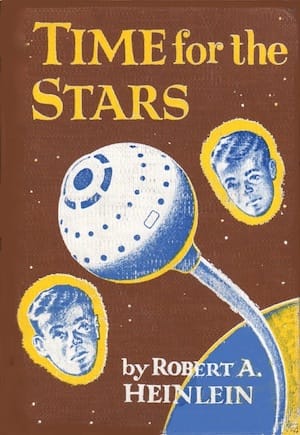
With torchships able to sustain high accelerations indefinitely, sublight exploration of nearby solar systems is now practical. The time lag imposed by relativity could be problematic, but the Long Range Foundation has a workaround. Starships may be subject to Einstein’s limits, but communication need not be. Telepathic twins can relay messages across interstellar space instantly.
Tom is one such communications apparatus, dispatched to report on the worlds discovered by the torchship Lewis and Clark. First destination: Tau Ceti’s planet Constance, which proves hearteningly habitable. This proves not entirely a plus, as biocompatibility allows an alien disease to kill many crewmembers. Worse, Constance may be the least lethal life-bearing world encountered on the mission. Perhaps Tom would have been better off staying home.
I could ask in what frame telepathy is instant but A: it is clear that telepathy breaks relativity, and B: I would much rather complain about Heinlein’s egregious misunderstanding of mass ratios and time dilation in this novel. Well, that and the unwelcome appearance of “the protagonist who woos a much younger relative” trope.
The Tower of Zanid by L. Sprague de Camp (1958)
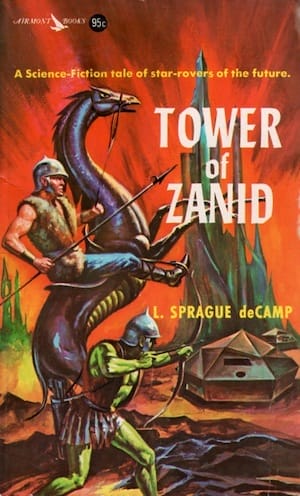
Anthony Fallon was once ruler of minor kingdom on the Tau Ceti world Krishna. Matters did not develop necessarily to his advantage. Deposed, Fallon has to settle for a humbler existence as an ill-paid spy. No surprise, then, that the adventurer accepts a risky job accompanying archaeologist Julian Fredro to investigate the enigmatic Safq tower.
Fallon is cheerfully amoral and utterly confident. He is sure that he can keep all of his plates spinning, or at least exit before the falling dishes hit the stage. As the loss of his kingdom shows, his confidence is misplaced—as the Terran will learn to his cost.
Fallon first appeared as a largely off-stage scoundrel in 1949’s The Queen of Zamba. Here he becomes an on-stage protagonist, although still a scallywag. By his third appearance in 1991’s The Swords of Zinjaban, he is a government bureaucrat. That’s an unusual career arc.…
Barbarella, based on the comic of the same title by Jean-Claude Forest and directed by Roger Vadim (1968)
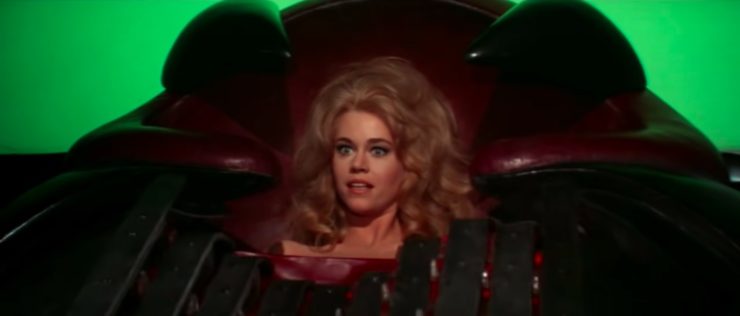
Scientist Durand Durand has vanished, quite possibly with some malign intent in mind. Barbarella (played by Jane Fonda) is dispatched to Tau Ceti to find and detain Durand Durand. If she fails, he will use his positronic ray to “deminimalize (victims) to the fourth dimension.” Which would be bad.
In theory, Barbarella, as the product of Earth’s highly advanced but austere civilization, should have little trouble capturing her quarry. In practice, Tau Ceti’s Planet 16 (Lythion in the comic) proves to have any number of pitfalls for the hard-working Terran. While Earth has abandoned pleasures of the flesh, Planet 16 revels in them. Can Barbarella survive the salacious distractions that await her?
It’s possible that neither Jean-Claude Forest (comic author) nor Roger Vadim (film director) paid much attention to astronomical verisimilitude in creating their respective works. Nevertheless, an SF film featuring a real star (astronomical, not cinematic) not wildly inappropriate for a habitable world is uncommon enough to be worth mentioning.
Still Forms on Foxfield by Joan Slonczewski (1980)
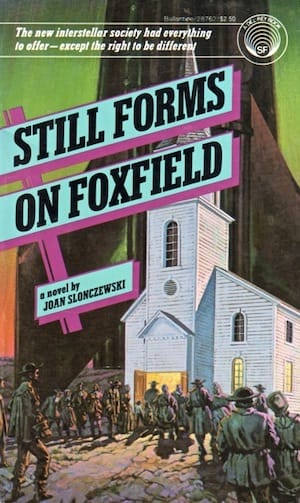
Fleeing a war that could end in nuclear holocaust, Quakers escaped to Tau Ceti in a surplus starship. Communication was impossible in flight. Having arrived at the target system, the Quakers hear only silence from Earth and fear the worst. While their new home, which the humans name Foxfield, is already occupied, the indigenous aliens are willing to co-exist with humans.
Eighty years later, a United Nations Interplanetary starship appears in orbit to declare the UNI’s ownership of Foxfield. Many elements of the UNI culture are abhorrent to the Quakers. The UNI has a vast population, advanced technology, and little interest in compromise. The future looks quite grim for our Quakers.
Generally speaking, any imperialist power asserting their rule over a planet populated by sympathetic humans and enigmatic aliens should first determine if the aliens are the sort of enigmatic aliens who command powers beyond human ken. For some reason, imperialists rarely bother.
The Sails of Tau Ceti by Michael McCollum (1993)
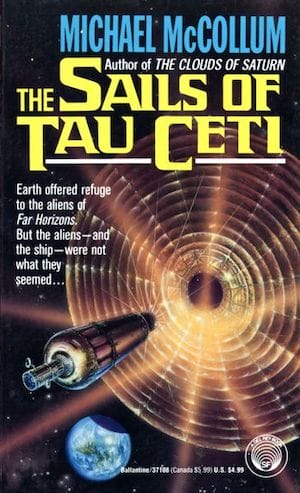
Despite being on the brink of sublight interstellar travel, nobody in the Solar System has any interest in settling the habitable worlds orbiting Tau Ceti. This is because centuries before, on August 25, 2001, Tau Ceti went nova for reasons still not understood. If Tau Ceti had Earthlike worlds, they perished in the nova.
Tau Ceti had inhabited planets. Two hundred years post-nova, a light-sail-propelled alien starship arrives at Sol. Its crew begs refuge from humanity but are willing to accept no as an answer. The catch? There are more aliens following, billions of aliens. Saying yes means committing to accommodating them all. At the same time, the fleet has extreme propulsive needs and to meet them, the aliens plan to nova the Sun and harvest its energy. Saying no could turn out to be equivalent to self-destruction.
***
There are any number of stories set near Tau Ceti.1 If I overlooked your favorite, feel free to mention it in comments below.
I should add that it’s almost always the case that when science finally learns more about exoplanets or stellar systems on which SF authors placed their hopes, the revelations that follow are disappointing. In the case of Tau Ceti … perhaps not so much. At least two of the worlds believed to orbit Tau Ceti may be in its Goldilocks zone. True, both are more massive than Earth, but this could be a benefit to human cardiovascular systems!
In the words of fanfiction author Musty181, four-time Hugo finalist, prolific book reviewer, and perennial Darwin Award nominee James Davis Nicoll “looks like a default mii with glasses.” His work has appeared in Interzone, Publishers Weekly and Romantic Times as well as on his own websites, James Nicoll Reviews (where he is assisted by editor Karen Lofstrom and web person Adrienne L. Travis) and the 2021, 2022, and 2023 Aurora Award finalist Young People Read Old SFF (where he is assisted by web person Adrienne L. Travis). His Patreon can be found here.
[1]For more Tau Ceti discussion, you might want to look at Andrew Liptak’s 2015 article “Visiting Tau Ceti with Four Science Fiction Authors”: https://www.barnesandnoble.com/blog/sci-fi-fantasy/visiting-tau-ceti-with-four-science-fiction-authors/










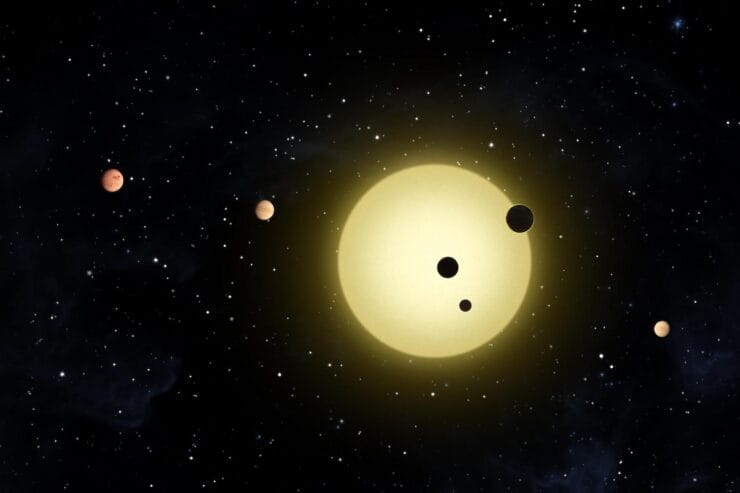
As I recall, Tau Ceti is the home system of the Lizards from Harry Turtledove’s Worldwar and sequels – some humans finally get to visit it in the last book, Homeward Bound.
Is this the first time that Heinlein does the creepy thing with time travel and a younger sex interest? It’s a big theme with him, along with the older man who is surrounded by attractive assistants, and several other tropes. “Dear Amazing Stories, I never dreamed it would happen to me….”
Pell Station orbits Pell’s World, also known as Downbelow, which in turn orbits Tau Ceti in C J Cherryh’s Alliance/Union stories.
No “The Dispossessed”? Just too obvious?
S
In his Leshy Circuit short story “The Fourth Profession” (1971), Larry Niven used a very similar motive to The Sails of Tau Ceti: The Monks, who are visiting Earth for trading purposes, arrived via a light sail journey. They ask humanity to build them a launching laser so they can move on to the next star. If Earth cannot or will not build their launcher, they will make the sun explode, so their lightsails can use the brightened light to accelerate to cruising speed to the next star.
I don’t think Tau Ceti is explicitly called out at all; the home-world of Monks is not mentioned — Monks are extremely private — and their previous port of call was somewhere in the Sagittarius constellation as seen from Earth. So I guess this whole comment is off-topic for this particular post.
Still, the similarity is interesting, and Niven’s story antedates McCollum’s novel by twenty-two years. Anyone know of any other stories with that setup — lightsail aliens threatening to destroy the Sun?
@5 – Stephen Baxter’s Space: Manifold 2 has a nomadic space-faring alien civilization that routinely causes suns in each system they sequentially visit to go nova to propel them to the next system.
And once again I am put in mind of Dan Simmons’s amazing Hyperion Cantos, with humanity’s government cited on “Tau Ceti Center” (called TC squared in the books)
5: While their works are distinct, it is not unknown for Niven and McCollum to have works incorporating similar elements. USENET’s John Carr observed that in addition to the Fourth Profession <> Sails parallels, there are similarities between The Mote in God’s Eye and the Antares series. In addition to that, one might find the following pairs of works have similar elements:
Svetz and A Greater Infinity are both fixups of a guy working in the (para)time travel industry. Svetz has by far the worse working conditions, as the AGI protagonist is not the straight man in a long series of jokes at his expense.
Lucifer’s Hammer and Thunderstrike! both involve impacts. Lucifer’s Hammer involves a lot more cannibalism on the part of people the authors dislike. I don’t think Thunderstrike has any.
The Probe duology might be weakly analogous to Protector: interstellar visitor forces humanity to acknowledge the Milky Way is much larger than our little corner of it. Whereas Niven does terrible things to biology, McCollum does not.
Clouds of Saturn and A Gift from Earth both involve a human colony with social problems on a largely hostile world receiving technology from Earth which has profound implications for them.
That said, while they share some details, the works are all quite distinct from each other. Nobody will ever be confused which author or which book they are reading.
As I recall, McCollum described back in USENET days the thought process behind Antares’ interstellar travel. It was not a case of “Oh, Mote’s looks cool. I will lift that [1].” He had the same narrative needs N&P had in Mote: however FTL worked, it had to lend itself to extended wars, not MAD-style affairs where ships pop out of hyperspace to glass planets. Jump points provide that.
(Sorry about the typos. New sleep med)
1: Not there’s anything wrong with appropriating interesting props. How many SF books have ansibles?
Andy Weir’s book Project Hail Mary mostly takes place in and around Tau Ceti. And was written after its planets were found.
“Fleeing a war that could end nuclear holocaust, Quakers escaped” Or should it be “end in nuclear holocaust”
…it is not unknown for Niven and McCollum to have works incorporating similar elements. USENET’s John Carr observed that in addition to the Fourth Profession <> Sails parallels…
I have no memory of seeing that discussion on rec.arts.sf.written but, wow, that’s just the kind of SF neepery I’d have loved to participate in. I’m glad you remembered it.
@@@@@2, Bill Altreuter:
Time for the Stars and Door into Summer came out the same year, so they’re tied for first place in the crowded field of “Heinlein works that feature adults marrying someone they were once in a paternal relationship to.”
Semi on-topic, “Electric Barbarella” by Duran Duran came out in the late 90’s.
enigmatic aliens who command powers beyond human ken
In other words, they are capable of jobs beyond “Beach”.
Wow, good evidence that the last time I read Time for the Stars, I was fourteen years old and a heck of a lot more clueless!
The new hard sci fi novel Project Hail Mary (from The Martian’s Andy Weir) involves Tau Ceti quite heavily.
Thinking of Niven, he set the worlds of his Known Space series around stars in the local group. Tau Ceti was home to Plateau, setting for A Gift From Earth.
@12 in Time for the Stars, although Vicki is close to Tom’s age because of the time dilation, she’s actually his grand-niece, and he’s been in telepathic contact with her since she was an infant, adding an extra level of ick.
Tau Ceti is also the potential end goal of the Locked Tomb series. It was at least the original goal for a lot of very old characters.
Tau Ceti comes up several times in Bujold’s Vorkosigan novels, though none of the “on screen” action takes place there.
Ceta is in Tau Ceti in Gordon Dickson’s Childe Cycle
In Samuel R. Delany’s novella “Empire Star,” Comet Jo is from a planet of Tau Ceti. Also, the destination of the generation ship in Kim Stanley Robinson’s recent Aurora is in the Tau Ceti system.
I saw an HBO special on the Fun Machine in Barbarella and some artful mechanic who decided to build it (with a willing wife to test it out).
I’d just like to add a more modern Tau ceti story: Project Hail Mary by Andy Weir.
Surprised to see no mention of Harry Turtledove’s Worldwar series
@25 — First comment, amigo.
Frank Herbert’s malfunctioning starship in Destination Void was supposed to have that as its original destination. Although I forget whether that was real or one of the deceptions that the crew had been subjected to.
Although not directly featuring Tau Ceti, The Expanse mentions the system as the original destination of the LDSS Nauvoo.
Legacy of Heorot by Niven, Pournelle, and Barnes takes place in the Tau Celtic system